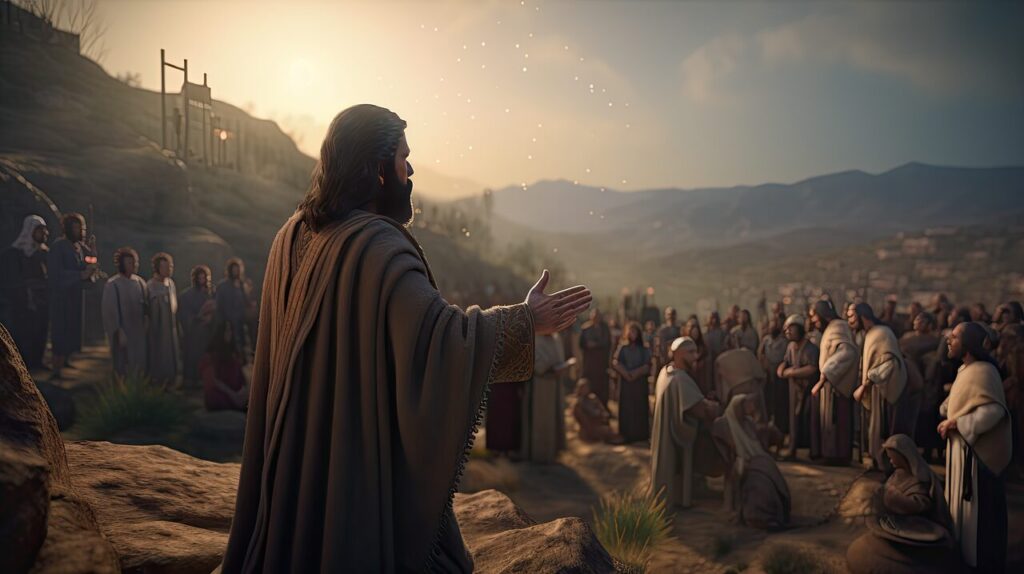The Olivet Discourse: Background, Context, and Analysis of Matthew 24:1-3
Introduction
The Olivet Discourse, recorded in Matthew 24, Mark 13, and Luke 21, is one of Jesus Christ’s most profound teachings concerning eschatology—the study of the end times. Matthew 24:1–3 sets the stage for this critical discourse, where Jesus prophesies the destruction of the Jerusalem Temple and addresses the rapture, the day of the Lord, and His second coming. This discourse provides a sequential understanding of end-time events and highlights Jesus as the pioneer of eschatological studies.
This article explores the background, context, and analysis of Matthew 24:1–3, focusing on the prophecy of the Temple’s destruction, its fulfillment, and how it connects to future prophetic events.
Background of the Olivet Discourse
The Olivet Discourse derives its name from the Mount of Olives, where Jesus delivered this profound teaching. It occurred during the final week of His earthly ministry, just before His crucifixion, and Jesus had taught considerably in the Temple. The discourse follows His public denunciation of the religious leaders in Matthew 23, where He laments over Jerusalem’s coming judgment.
The setting is significant. The Temple in Jerusalem was the center of Jewish religious life and a symbol of national identity and divine presence. Herod’s Temple was a magnificent structure, and the disciples were astonished when Jesus predicted its destruction (Matthew 24:2).
Context of Matthew 24:1–3
1. Jesus’ Departure from the Temple (Matthew 24:1)
“Jesus left the temple and was walking away when his disciples came up to him to call his attention to its buildings.” (Matthew 24:1, NIV)
The disciples admired the grandeur of the Temple. However, Jesus’ departure symbolized the end of an era—God’s judgment upon the nation for rejecting His Messiah. This action fulfills prophetic imagery seen in Ezekiel when the glory of the Lord departed from the Temple (Ezekiel 10–11).
2. The Prophecy of the Temple’s Destruction (Matthew 24:2)
He asked, “Do you see all these things?”. Not one stone here will remain upon another.
The prophecy came true in 70 A.D. when Roman forces under Titus destroyed Jerusalem and the Temple. The Romans dismantled the Temple stone by stone to retrieve the melted gold during the fire. This historical event validated Jesus’ prophecy, establishing His credibility as a true prophet.
3. The Disciples’ Questions (Matthew 24:3)
“As Jesus sat on the Mount of Olives, the disciples came to him privately. ‘Tell us,’ they said, ‘when will this happen, and what will be the sign of your coming and the end of the age?’”
The disciples asked three interrelated questions:
- When will the Temple be destroyed?
- What will be the sign of Your coming?
- What will be the sign of the end of the age?
Jesus’ response provides a sequential framework for understanding the end times, addressing the Temple’s near-term destruction and long-term eschatological events.
Analysis of the Olivet Discourse
1. The Destruction of the Temple: Prophetic Fulfillment
The destruction of the Temple in 70 A.D. serves as a historical marker and a foreshadowing of future judgment. This event signified the end of the old covenant sacrificial system for first-century believers. Theologically, it underscored that God’s presence no longer dwelt in a physical structure but in the person of Jesus Christ and His followers (1 Corinthians 3:16).
2. The Rapture: Gathering of the Elect
In Matthew 24:31, Jesus describes the gathering of His chosen ones: “He will send his angels with a loud trumpet call to gather those he has chosen from the four winds, from one end of the heavens to the other.”
While interpretations vary regarding the rapture timing (pre-tribulation, mid-tribulation, or post-tribulation), the Olivet Discourse suggests a mid-tribulation context, where believers endure tribulation before being gathered by Christ.
3. The Day of the Lord: Divine Judgment
The “day of the Lord” refers to God’s climactic intervention in history to judge the wicked and deliver the righteous. As Matthew 24:29-30 states, the cosmic upheaval preceding Christ’s return will manifest as: “Immediately after the distress of those days(The Great tribulation), the sun will be darkened, and the moon will not give its light.”
This language echoes Old Testament prophetic texts (Isaiah 13:9–10; Joel 2:31) and signals the onset of divine judgment. The day of the Lord is both a day of wrath for unbelievers and redemption for those who have trusted in Christ.
4. The Second Coming: The Glorious Return of Christ
Matthew 24:30 declares, “Then the sign of the Son of Man will appear in heaven. And then all the peoples of the earth will mourn when they see the Son of Man coming on the clouds of heaven, with power and great glory.”
The second coming of Christ will be visible, personal, and glorious. Unlike His first coming, which was humble, Jesus will return as King and Judge. This event will bring history to its climax, establishing His millennial reign and fulfilling God’s redemptive plan.
Jesus as the Pioneer of Eschatology
Jesus’ teaching in Matthew 24 establishes a chronological framework for understanding end-time events. His discourse covers:
- Sign of the Times and the end of the age (Matthew 24:4–14)
- The abomination of desolation (Matthew 24:15–28)
- The coming of the Son of Man (Matthew 24:29–31)
- Lessons from the fig tree and the call to watchfulness (Matthew 24:32–51)
By sequencing these events, Jesus provided a roadmap for future prophetic understanding. His teachings laid the foundation for the apostles’ eschatological writings, particularly in the Pauline epistles and the book of Revelation.
Conclusion
The Olivet Discourse in Matthew 24:1–3 is foundational for understanding biblical prophecy and eschatology. Jesus’ prophecy concerning the destruction of the Temple was historically fulfilled in 70 A.D., confirming His role as a true prophet. However, the discourse extends beyond this immediate event to address the rapture, the day of the Lord, and His second coming.
Jesus pioneered the study of eschatology by presenting a sequential and coherent narrative of end-time events. His teachings remain vital for believers today, calling them to vigilance, faithfulness, and hope as they await His glorious return. The Olivet Discourse reveals the future and challenges believers to live lives worthy of His coming kingdom.
The World of Eschatology Podcast
- Olivet Discourse
- Matthew 24:1–3
- Destruction of the Temple prophecy
- Eschatology in the Bible
- The rapture in Matthew 24
- Day of the Lord’s biblical meaning
- Second coming of Jesus Christ
- Jesus’ teachings on end times
- Biblical prophecy fulfillment
- End times in the New Testament
By understanding the Olivet Discourse and its significance, readers can gain deeper insight into God’s plan for the future and the hope of Christ’s return, encouraging them to be spiritually prepared for the coming days.

